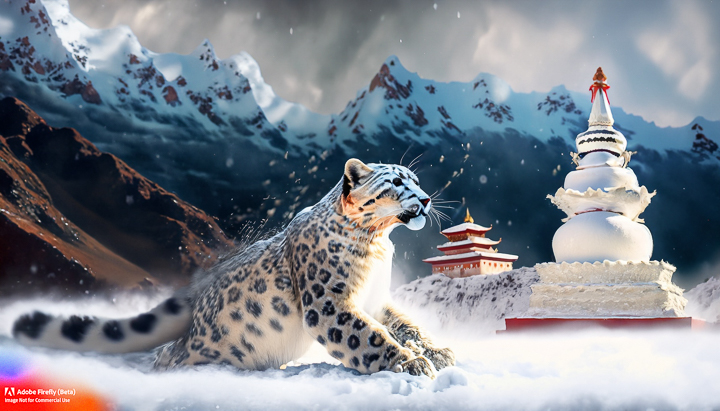Exploring the Enchanting World of Snow Leopards: Guardians of the Himalayas

Nestled high in the majestic Himalayan mountains, the elusive and endangered snow leopards (Panthera uncia) roam the vast and rugged landscapes, embodying a mystical allure that captivates the imagination. Often referred to as the “ghosts of the mountains,” these solitary and elusive creatures are a symbol of resilience and adaptability in one of the harshest environments on Earth.
Habitat and Distribution:
Snow leopards are primarily found in the high-altitude regions of Central Asia, spanning across 12 countries, including Afghanistan, Bhutan, China, India, Kazakhstan, Kyrgyzstan, Mongolia, Nepal, Pakistan, Russia, Tajikistan, and Uzbekistan. Their habitat ranges from rocky mountainous terrains to alpine meadows, where they navigate steep cliffs and rocky outcrops with remarkable agility.
Physical Characteristics:
Snow leopards are renowned for their stunning fur coat, which provides excellent camouflage against the snowy landscapes of their habitat. The coat is thick and insulated, with a base color ranging from pale gray to yellowish-tan, adorned with distinctive dark rosettes and spots. Their long, bushy tail serves as a balance mechanism and helps them maintain stability on treacherous terrain. Snow leopards also boast powerful hind limbs, enabling them to leap great distances and scale steep slopes with ease.
Behavior and Lifestyle:
Snow leopards are predominantly solitary creatures, and their elusive nature makes them a challenging subject for scientific study. These cats are crepuscular, meaning they are most active during dawn and dusk, utilizing their keen senses of sight and hearing to navigate their surroundings. Their solitary lifestyle is essential for survival in the harsh mountain environment, as it minimizes competition for resources.
Diet and Hunting:
Snow leopards are opportunistic predators, preying on a variety of mountain-dwelling species such as blue sheep (bharal), Himalayan tahr, marmots, and pikas. Their powerful hind limbs allow them to execute incredible leaps, enabling them to ambush prey from a distance. The snow leopard’s secretive nature and stealthy hunting techniques make them efficient predators in their harsh habitat.
Conservation Status and Threats:
Despite their remarkable adaptations, snow leopards face numerous threats that have led to their classification as vulnerable by the International Union for Conservation of Nature (IUCN). Habitat loss, retaliatory killings by local herders to protect livestock, and the illegal wildlife trade are among the primary threats to their survival. Conservation efforts are underway to address these challenges, including the establishment of protected areas, community-based conservation initiatives, and anti-poaching measures.
Conservation Initiatives:
Several organizations and governments are actively engaged in the conservation of snow leopards. The Snow Leopard Trust, Panthera, and the World Wildlife Fund (WWF) are just a few of the entities working to protect these magnificent creatures. Conservation strategies include community-based approaches that involve local communities in the monitoring and protection of snow leopards, as well as initiatives to reduce human-wildlife conflict and promote sustainable practices.
Cultural Significance:
Snow leopards hold significant cultural importance in the regions where they roam. In many Central Asian cultures, these elusive cats are revered as symbols of strength, grace, and mystery. Local communities often incorporate snow leopards into their folklore, myths, and religious traditions, further emphasizing the deep connection between these majestic creatures and the people who share their habitat.
Tourism and Responsible Eco-Tourism:
As awareness of snow leopards grows, eco-tourism has become a tool for both conservation and education. Responsible tourism initiatives focus on providing sustainable economic opportunities for local communities while raising awareness about the importance of preserving snow leopard habitats. Guided tours, educational programs, and community-based homestays offer visitors a chance to experience the beauty of the Himalayas while contributing to conservation efforts.
Conclusion:
Snow leopards, with their mystical charm and adaptive prowess, stand as guardians of the Himalayas, embodying the delicate balance between nature and the challenges posed by human activities. As we continue to explore and understand these elusive creatures, it becomes increasingly crucial to implement effective conservation measures that not only protect the snow leopards but also ensure the preservation of the unique ecosystems they call home. Through a collective effort of local communities, governments, and conservation organizations, we can aspire to secure the future of these remarkable felines and the breathtaking landscapes they inhabit.
1. What is a snow leopard, and where is it found?
- A snow leopard (Panthera uncia) is a large cat native to the mountainous regions of Central Asia. Its range includes countries such as Afghanistan, Bhutan, China, India, Kazakhstan, Kyrgyzstan, Mongolia, Nepal, Pakistan, Russia, Tajikistan, and Uzbekistan.
2. Why are snow leopards often referred to as the “ghosts of the mountains”?
- Snow leopards are elusive and solitary creatures with a remarkable ability to blend into their snowy surroundings. Their elusive nature and infrequent sightings have earned them the nickname “ghosts of the mountains.”
3. What does a snow leopard look like?
- Snow leopards have a thick fur coat with a base color ranging from pale gray to yellowish-tan. They are adorned with distinctive dark rosettes and spots. Their long, bushy tail, powerful hind limbs, and well-adapted body help them navigate the steep and rocky terrains of their habitat.
4. What is the conservation status of snow leopards?
- Snow leopards are classified as vulnerable by the International Union for Conservation of Nature (IUCN). They face threats such as habitat loss, retaliatory killings by herders, and illegal wildlife trade.
5. What do snow leopards eat, and how do they hunt?
- Snow leopards are opportunistic predators, preying on blue sheep (bharal), Himalayan tahr, marmots, and pikas. They are known for their stealthy hunting techniques, using their powerful hind limbs to execute incredible leaps and ambush prey from a distance.
6. How do snow leopards adapt to their harsh environment?
- Snow leopards have evolved various adaptations to survive in high-altitude, mountainous regions. Their thick fur provides insulation against the cold, and their large nasal cavities and lungs help them extract oxygen from thin mountain air.
7. What are the main threats to snow leopards?
- The primary threats to snow leopards include habitat loss due to human activities, retaliatory killings by herders to protect livestock, and illegal wildlife trade. These factors contribute to their vulnerable conservation status.
8. Are there conservation initiatives for snow leopards?
- Yes, several organizations, such as the Snow Leopard Trust, Panthera, and the World Wildlife Fund (WWF), are actively involved in snow leopard conservation. Efforts include creating protected areas, community-based conservation initiatives, and anti-poaching measures.
9. How do snow leopards contribute to local cultures?
- Snow leopards hold cultural significance in many Central Asian societies, often symbolizing strength, grace, and mystery. They are featured in folklore, myths, and religious traditions, emphasizing the deep connection between these majestic cats and local communities.
10. Can I see snow leopards in the wild?
- Observing snow leopards in the wild can be challenging due to their elusive nature and remote habitat. However, responsible eco-tourism initiatives offer opportunities for enthusiasts to contribute to conservation efforts while experiencing the breathtaking landscapes where snow leopards roam.






